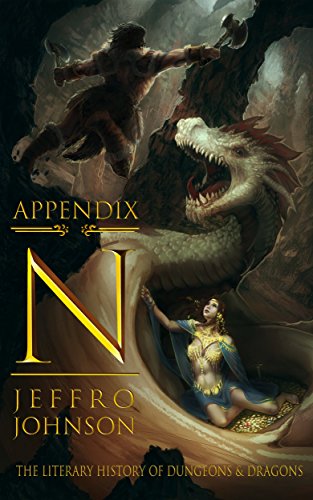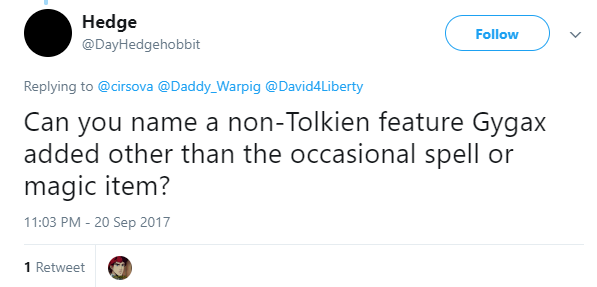I was wondering if perhaps I had overstated my case in claiming that most people wrongly assume that D&D sprang from Tolkien’s approach to fantasy… but no, it really is par for the course:
Let’s review, shall we…?
- The OD&D three-point alignment system, the AD&D Paladin class, and regenerating trolls were all lifted wholesale from Poul Anderson’s Three Hearts and Three Lions. Additionally, the book explains the broader context behind why a Keep on the Borderlands would be a particularly significant location for fantasy role-playing adventure.
- The idea that players would naturally advance to the point where they could stand up against gods and demons in battle derives from Michael Moorcock’s The Stealer of Souls.
- The thief class is an amalgam of Fritz Leiber’s Grey Mouser, Jack Vance’s Cugel the Clever, and Roger Zelazny’s Jack of Shadows. The latter is why thieves have a “hide in shadows” ability rather than a generic (and mundane) stealth skill; it’s also why thieves are unaccountably good at climbing. All of these characters are why thieves and rogues in early fantasy role-playing games have far more magical ability than what most people would tend to given them these days.
- Most everyone knows that the D&D magic system is pulled from Jack Vance’s The Dying Earth. Fewer know that the concept for reversing spells is taken directly from The Eyes of the Overlord.
- The inspiration for the AD&D planar cosmology is from de Camp and Pratt’s The Fallible Fiend, though Moorcock also contributed to this aspect of the game.
- The AD&D system of spell components is taken from de Camp and Pratt’s Harold Shea stories. Also, the setting for module G1 Steading of the Hill Giant Chief is pulled verbatim from de Camp and Pratt’s The Roaring Trumpet, as are dragons that breath clouds of chlorine gas.
- The nucleus of the AD&D psionics system comes from Sterling Lanier’s Heiro’s Journey. (The green slime monster is also plundered from this novel in addition to large swaths of Gamma World.)
- The template for the Gygaxian mega-dungeon is pulled from Margaret St. Clair’s The Sign of the Labrys.
- The idea that it would make sense to simply plunder every mythos from every culture in the world is a touchstone of early D&D. You will also find this approach to fantasy in Poul Anderson’s The Broken Sword.
- The “fighting man” class of OD&D is based on John Carter of Mars and Barsoom puts in an appearance in the OD&D wilderness encounter tables. The “White Ape” from the Moldvay Basic Set is another clue regarding the primacy of Edgar Rice Burroughs in classic fantasy games.
 Can you imagine flipping through The Lord of the Rings and finding detailed descriptions of The Law of Contagion and the somatic components of Saruman’s spells…? How about a barbarian that kills a god with his sword forged from star metal? Or a guy that goes on an adventure with Thor and Loki? Spells that you “forget” when you cast them…? Space aliens? Chinese demons, the Tuatha Dé Danann, and an Efreet all in the same story? Weird powers of the mind? Robots? Radium rifles? Travels to other worlds? Fantasy cities replete with a ridiculous “thieve’s guild”…? Sounds crazy, doesn’t it? But that is exactly the sort of spirit that ran rampant during the early days of fantasy role-playing.
Can you imagine flipping through The Lord of the Rings and finding detailed descriptions of The Law of Contagion and the somatic components of Saruman’s spells…? How about a barbarian that kills a god with his sword forged from star metal? Or a guy that goes on an adventure with Thor and Loki? Spells that you “forget” when you cast them…? Space aliens? Chinese demons, the Tuatha Dé Danann, and an Efreet all in the same story? Weird powers of the mind? Robots? Radium rifles? Travels to other worlds? Fantasy cities replete with a ridiculous “thieve’s guild”…? Sounds crazy, doesn’t it? But that is exactly the sort of spirit that ran rampant during the early days of fantasy role-playing.
D&D is just an unbelievably weird game. It is nothing like the carefully constructed lore, and mythology, and languages of J. R. R. Tolkien. Going by the example of Gygax and the other pioneers of fantasy role-playing, the concept for the game was that you could take anything from any story or legend, add it to the game, and just play the heck out of it. Genre distinctions meant nothing. If you wanted a monk character pulled straight out of nineteen-seventies kung fu movies, it was on the table. And if you wanted him to fight the displacer beast from A. E. Van Vogt’s science fiction classic “Black Destroyer”, you could expect to meet it in the same world that hosted more traditional creatures from Greek mythology like satyrs, minotaurs, dryads, and gorgons.
And if that world was not enough, there was nothing stopping players from using spells and artifacts from Dr. Strange comics to travel to the Jack Vance’s Planet of Adventure. Oh sure, there were elves and dwarves and balrogs and hobbits and rangers and orcs and half-orcs and magic rings in there, too. But they were in a place where practically anything ever imagined was in play. Such a place has next to nothing in common with Tolkien’s Middle Earth.
I’ve always felt that LOTR was actually a pretty bad setting for gaming precisely because Tolkien was so meticulous about laying everything out and how his setting worked that it didn’t leave a lot of wiggle room. It seems too constrictive for a game.
I can see the notion of a racially diverse party being popularized by LOTR, and maybe a few creatures, but that’s really about it and even then the Fellowship doesn’t look anything like your average D&D adventuring party (who the hell allows four halflings in?).
OK.
Other than those, Hedge was right.
“But-but-but… all those things were written before I was born!”
Memory-holes are designed to push things IN, not pull things OUT of.
I wonder how many people now (myself included) read Jack Vance when they otherwise might not have thanks to hearing of him from D&D times?
The only thing we pulled from Tolkien were the concept of Elves as an ancient noble race rather than Fae.
I may be mistaken but I believe that the concept of half-elves came from Tolkien’s character of Elrond. Of course thanks to Peter Jackson, most don’t realize that he was half elven.
D&D may have borrowed heavily from Tolkein, but with all of the other elements it’s taken from other genere, synthesized them and become it’s own genera. Also, you can do almost anything with it. I’ve run classic fantasy campaigns, pirate adventures, horror, post-apocalyptic, and even weird sci-fi with it, and the system supported it perfectly.
Hedgehobbit here. This post shows why Twitter isn’t very good for stuff like this. My tweet was in response the the assertion that Gygax, and Gygax specifically, changed D&D to be less Tolkieny.
I’ll go through your points one by one:
1) I concede the Paladin but raise you the Ranger. The Druid is also a non-Tolkien class added by Gygax so he’s +1 at this point.
2) Gygax wasn’t in favor of fighting gods and mocked such play. See the forward of GD&H for the party line.
3) The Thief class wasn’t added by Gygax
4) The magic system in D&D is fairly close to that in Blackmoor. Gygax added the idea of spell levels and used “memorization” to simplify the mechanics (see #6)
5) I’m not familiar enough with this to discuss.
6) Dave Arneson’s original spell system was entirely based on components. You’d mix up the spell (like a potion or scroll) and cast them in-game. The types of spells you could carry around were based on your own research with a fixed limit based on level. All Gygax did was remove the spell creation portion. Spell components were added back in in AD&D.
7) Nobody used Psionics so I wouldn’t call this a major addition.
8) The structure of the mega-dungeon comes entirely from Dave Arneson, not some obscure novel. Again, this isn’t something that Gygax did himself.
9) Gygax needed content to sell books. So he borrowed from various sources. I’ll admit that a large number of monsters, spells, and magic items come from non-Tolkien sources. But that doesn’t change the fact that just about everything mentioned in Tolkien (including very specifically Tolkien things like elven mail) is all over the place.
10) This one is a bit of a stretch. The fighting man comes directly from Chainmail which is a straight medieval fantasy game (at least with its supplement). John Carter was so foreign to the Chainmail/D&D fighting man that TSR actually produced a separate John Carter game to emulate him (which is a pretty good game by the way).
All that being said, I still don’t buy the line that Gygax set out to distance Arneson’s game from Tolkien. He could easily have removed the blatant Tolkien references (Hobbits, Ents, Balrogs) but chose not to.
Not only did he keep them, but he doubled down in AD&D by including a set of playable races straight out of Middle Earth (the only outlier being the gnome).
I know that the common OSR narrative is that Gygax kept those things in the game to appeal to Tolkien fans but he didn’t have to and the fact that he felt compelled to do so speaks volumes about Tolkiens influence in fantasy at the time.
When I started playing D&D in the late 1970s I didn’t know anyone who had read The Lord Of The Rings. We were familiar with The Hobbit, but it was considered a kid’s book, not all that significant. Our big influences were Amber, Elric, and Conan.
Now, obviously we weren’t involved in creating the game. However, the fact that we could play the game with enjoyment and enthusiasm without ever having read Tolkien’s longer work argues against the centrality of The Lord Of The Rings to the game.
-
You don’t need to have read Tolkien to play D&D as D&D teaches you everything you need to know about Tolkien already.
I hadn’t read Tolkien before I started playing D&D (I was a sci-fi fan at the time). But when I did finally read The Hobbit, it read like the official D&D novelization.
“My tweet was in response the the assertion that Gygax, and Gygax specifically, changed D&D to be less Tolkieny.”
Maybe I misunderstood, but I thought the assertion was that D&D had *very little to do with Tolkien in the first place*, except for some cosmetic features added specifically to cash in on the success of LOTR.
Gygax used the Bible and Christianity for a lot of his cleric spells. Bless, create food and drink, cure wounds, cure disease, sticks to snakes, and raise dead come to mind.
As someone who read LOTR before encountering DnD, I can’t say I found them to have anything much in common, with the exception of the word “elf” and the concept of “halflings”.
It was only later, approaching DnD as a very different thing and finally, reading Jeffro’s Appendix N, that DnD became something fun rather than frustrating, and then began to make actual sense.
The notion of Clerics or even paladins is completely foreign to Middle Earth, as is the spell caster per-se, and the range of DnD spells in particular. Summoning, planar cosmology, etc, are all at 180 degrees to Middle Earth.
I just read L Sprauge DeCamp’s the Goblin Tower. It was published in 1968. If I did not know better, i would swear that I was reading somebody’ D&D adventure. There is a lot of non Tolkian influences.
